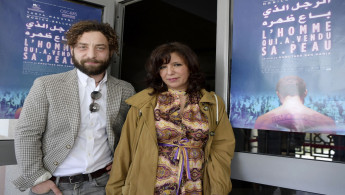The Man Who Sold His Skin: A provocative, powerful Oscar-nominated reframing of the refugee narrative
The Man Who Sold His Skin was inspired by another man who sold his skin, Tim Steiner, who provided his back as a canvas for Belgian artist Wim Delvoye to tattoo over a decade ago, and was bought by a German art collector for 150,000 euros (£130,000).
But in Ben Hania's movie, she has instead positioned a Syrian refugee as her eponymous hero who is painted with a Faustian brush, but given the heart of Orpheus as he endeavours to reunite with his love.
We meet our man Sam (Yahya Mahayni) in Syria during 2011, right when the civil uprising against Assad's regime was beginning to take form.
He is in a relationship with Abeer (Dea Liane) but when his declaration of love on a train is interpreted as revolutionary rhetoric by a government onlooker, he is jailed and the two lovers are separated.
Luckily, Sam manages to escape to Beirut where his path crosses with Belgian artist Jeffrey Godefroi (Koen De Bouw), a self-described "Mephistopheles" character who is known for "turning worthless objects" into works of art. Jeffrey offers him a deal and as with the infernal bargain offered by his demonic counterpart it comes with morally-questionable strings attached.
If the Syrian refugee allows himself to be turned into a living, tattooed sculpture, the artist will finance his Belgian citizen status that will stop him needing to steal food from buffets at gallery exhibitions and prevent the risk of being returned to Syria.
It will also allow Sam to pursue Abeer even though she has reluctantly accepted an arranged marriage with a diplomat working at the Syrian embassy in Brussels.
As a romantic in dire straits, the deal seems like a no-brainer, but from the moment Jeffrey's tattoo gun penetrates Sam's skin, the freedom he was assured comes at an increasingly dehumanising price.
 |
|
 |
A highly entertaining skewering of the refugee narrative that so often dictates our perception of those who were, in the words of Sam, 'not born on the right side of the world' |  |
The first broad steps of the film are those of a simple drama about class, displacement and the quest for a better life. It certainly lulls you into the idea that this would be another run-of-the-mill refugee story but Ben Hania never allows it to get that far by avoiding any trauma cliches.
She instead, morphs the narrative into a satirical indictment of the commodification of humanity for the sake of art.
Sam might have a Schengen Visa tattooed on his back but his freedom of movement is limited by the requirement for him to spend hours in museums being gawked at.
To have his existence subject to the whims of photographers, exhibitioners, art dealers and the artist while his worth as a person depreciates in value. In the eyes of the bourgeois establishment he is less a human, more a poster child for provocative art whose skin, and body that comes with it, can be sold to the highest bidder.
Cinematographer Christopher Aoun aptly reflects this uncomfortable dehumanisation in the way he frames Sam in relation to various inanimate art work how often his body is positioned in subordination to the other people in a scene.
A wonderful bathtub shot stands out for being reminiscent of John Everett Millais' Ophelia; whether that was an intentional nod to the 1852 painting or not, it's a testament to the filmmakers that their artistic world is so cleverly conceived and realised that it evokes such imagery.
|
|
Adding to that visual texture is a morbid humour, akin to Michael Lehmann's Heathers or Mary Harron's American Psycho, that undercurrents Sam's dark and twisted journey and Mahayni ensures the audience never loses affection for him.
The Syrian newcomer cuts an unassuming figure but emanating from his compact, muscular physique is an increasing array of keenly-felt emotions – anger, love, pride, jealousy, sadness, shame – as new conflicts threaten Sam's mental wellbeing.
Mahayni carries himself confidently against established European stars like De Bouw and Monica Bellucci who delivers her icy art dealer Soraya with luxurious superiority, though not without small moments of empathy when it counts, and this movie invokes a lot of it in the viewer.
The Man Who Sold His Skin is a brilliantly provocative and highly entertaining skewering of the refugee narrative that so often dictates our perception of those who were, in the words of Sam, "not born on the right side of the world."
By situating this modern myth in the underbelly of the contemporary art scene, Ben Hania holds up a mirror to the uneasy relationship between artistry and power that can often see humanity left at the gallery door.
It's no wonder the film has been nominated for an Oscar for Best International feature for it truly is a sight to behold.
Hanna Flint is a freelance film and TV critic, writer and interviewer who writes for The Guardian, Total Film, Time Out, Syfy, Yahoo Movies, SyFy and other international outlets.
Follow her here: @HannaFlint



